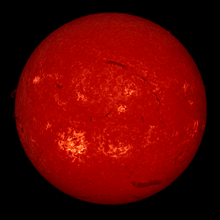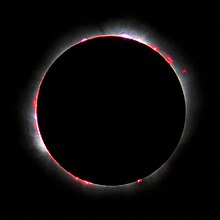
A corona is the outermost layer of a star's atmosphere. It is a hot but relatively dim region of plasma populated by intermittent coronal structures known as solar prominences or filaments.

The Sun is the star at the center of the Solar System. It is a massive, hot ball of plasma, inflated and heated by energy produced by nuclear fusion reactions at its core. Part of this energy is emitted from its surface as light, ultraviolet, and infrared radiation, providing most of the energy for life on Earth. The Sun has been an object of veneration in many cultures. It has been a central subject for astronomical research since antiquity.

The solar wind is a stream of charged particles released from the upper atmosphere of the Sun, called the corona. This plasma mostly consists of electrons, protons and alpha particles with kinetic energy between 0.5 and 10 keV. The composition of the solar wind plasma also includes a mixture of materials found in the solar plasma: trace amounts of heavy ions and atomic nuclei of elements such as C, N, O, Ne, Mg, Si, S, and Fe. There are also rarer traces of some other nuclei and isotopes such as P, Ti, Cr, and 58Ni, 60Ni, and 62Ni. Superimposed with the solar-wind plasma is the interplanetary magnetic field. The solar wind varies in density, temperature and speed over time and over solar latitude and longitude. Its particles can escape the Sun's gravity because of their high energy resulting from the high temperature of the corona, which in turn is a result of the coronal magnetic field. The boundary separating the corona from the solar wind is called the Alfvén surface.

A solar flare is a relatively intense, localized emission of electromagnetic radiation in the Sun's atmosphere. Flares occur in active regions and are often, but not always, accompanied by coronal mass ejections, solar particle events, and other eruptive solar phenomena. The occurrence of solar flares varies with the 11-year solar cycle.

The stellar atmosphere is the outer region of the volume of a star, lying above the stellar core, radiation zone and convection zone.

In solar physics, a spicule, also known as a fibril or mottle, is a dynamic jet of plasma in the Sun's chromosphere about 300 km in diameter. They move upwards with speeds between 15 and 110 km/s from the photosphere and last a few minutes each before falling back to the solar atmosphere. They were discovered in 1877 by Angelo Secchi, but the physical mechanism that generates them is still hotly debated.
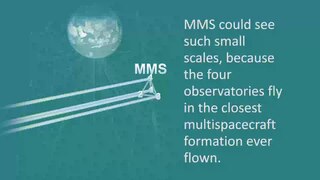
In plasma physics, an Alfvén wave, named after Hannes Alfvén, is a type of plasma wave in which ions oscillate in response to a restoring force provided by an effective tension on the magnetic field lines.
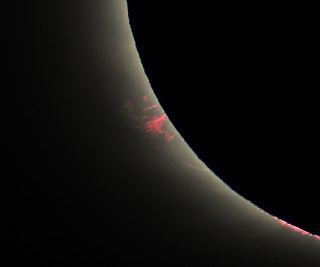
In solar physics, a prominence, sometimes referred to as a filament, is a large, shiny, reddish plasma and magnetic field structure extending outward from the Sun's surface, often in a loop shape. Prominences are anchored to the Sun's surface in the much brighter photosphere, and extend outwards into the solar corona. While the corona consists of extremely hot plasma, prominences contain much cooler plasma, similar in composition to that of the chromosphere.
The Evershed effect, named after the British astronomer John Evershed, is the radial flow of gas across the photospheric surface of the penumbra of sunspots from the inner border with the umbra towards the outer edge.
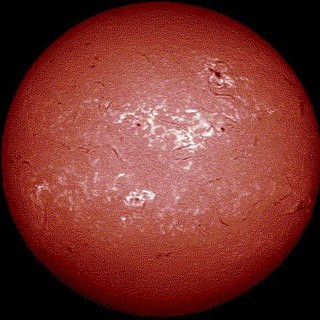
A plage is a bright region in the Sun's chromosphere, typically found in and around active regions. Historically, they have been referred to as bright flocculi, in contrast to dark flocculi, and as chromospheric faculae, in contrast to photospheric faculae.

In solar physics, a coronal loop is a well-defined arch-like structure in the Sun's atmosphere made up of relatively dense plasma confined and isolated from the surrounding medium by magnetic flux tubes. Coronal loops begin and end at two footpoints on the photosphere and project into the transition region and lower corona. They typically form and dissipate over periods of seconds to days and may span anywhere from 1 to 1,000 megametres in length.
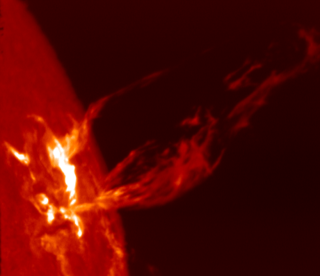
A stellar magnetic field is a magnetic field generated by the motion of conductive plasma inside a star. This motion is created through convection, which is a form of energy transport involving the physical movement of material. A localized magnetic field exerts a force on the plasma, effectively increasing the pressure without a comparable gain in density. As a result, the magnetized region rises relative to the remainder of the plasma, until it reaches the star's photosphere. This creates starspots on the surface, and the related phenomenon of coronal loops.
Coronal seismology is a technique of studying the plasma of the Sun's corona with the use of magnetohydrodynamic (MHD) waves and oscillations. Magnetohydrodynamics studies the dynamics of electrically conducting fluids - in this case the fluid is the coronal plasma. Observed properties of the waves (e.g. period, wavelength, amplitude, temporal and spatial signatures, characteristic scenarios of the wave evolution, combined with a theoretical modelling of the wave phenomena, may reflect physical parameters of the corona which are not accessible in situ, such as the coronal magnetic field strength and Alfvén velocity and coronal dissipative coefficients. Originally, the method of MHD coronal seismology was suggested by Y. Uchida in 1970 for propagating waves, and B. Roberts et al. in 1984 for standing waves, but was not practically applied until the late 90s due to a lack of necessary observational resolution. Philosophically, coronal seismology is similar to the Earth's seismology, helioseismology, and MHD spectroscopy of laboratory plasma devices. In all these approaches, waves of various kind are used to probe a medium.

Helmet streamers, also known as coronal streamers, are elongated cusp-like structures in the Sun's corona which are often visible in white-light coronagraphs and during solar eclipses. They are closed magnetic loops which lie above divisions between regions of opposite magnetic polarity on the Sun's surface. The solar wind elongates these loops to pointed tips which can extend a solar radius or more into the corona.

A nanoflare is a very small episodic heating event which happens in the corona, the external atmosphere of the Sun.
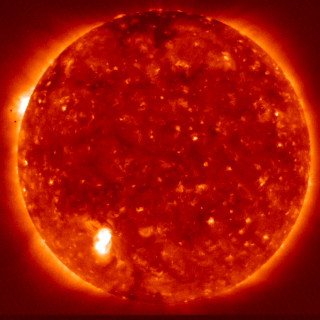
In astronomy and in astrophysics, for radiative losses of the solar corona, it is meant the energy flux radiated from the external atmosphere of the Sun, and, in particular, the processes of production of the radiation coming from the solar corona and transition region, where the plasma is optically-thin. On the contrary, in the chromosphere, where the temperature decreases from the photospheric value of 6000 K to the minimum of 4400 K, the optical depth is about 1, and the radiation is thermal.

AZ Cancri (AZ Cnc) is a M-type flare star in the constellation Cancer. It has an apparent visual magnitude of approximately 17.59.

Supra-arcade downflows (SADs) are sunward-traveling plasma voids that are sometimes observed in the Sun's outer atmosphere, or corona, during solar flares. In solar physics, arcade refers to a bundle of coronal loops, and the prefix supra indicates that the downflows appear above flare arcades. They were first described in 1999 using the Soft X-ray Telescope (SXT) on board the Yohkoh satellite. SADs are byproducts of the magnetic reconnection process that drives solar flares, but their precise cause remains unknown.
Solar radio emission refers to radio waves that are naturally produced by the Sun, primarily from the lower and upper layers of the atmosphere called the chromosphere and corona, respectively. The Sun produces radio emissions through four known mechanisms, each of which operates primarily by converting the energy of moving electrons into electromagnetic radiation. The four emission mechanisms are thermal bremsstrahlung (braking) emission, gyromagnetic emission, plasma emission, and electron-cyclotron maser emission. The first two are incoherent mechanisms, which means that they are the summation of radiation generated independently by many individual particles. These mechanisms are primarily responsible for the persistent "background" emissions that slowly vary as structures in the atmosphere evolve. The latter two processes are coherent mechanisms, which refers to special cases where radiation is efficiently produced at a particular set of frequencies. Coherent mechanisms can produce much larger brightness temperatures (intensities) and are primarily responsible for the intense spikes of radiation called solar radio bursts, which are byproducts of the same processes that lead to other forms of solar activity like solar flares and coronal mass ejections.
The Waves in the Lower Solar Atmosphere (WaLSA) team is an international consortium focused on investigating wave activity in the Sun's lower atmosphere. The team's research seeks to understand how magnetohydrodynamic (MHD) waves generated within the Sun's interior and lower atmosphere influence the dynamics and heating of its outer layers.
